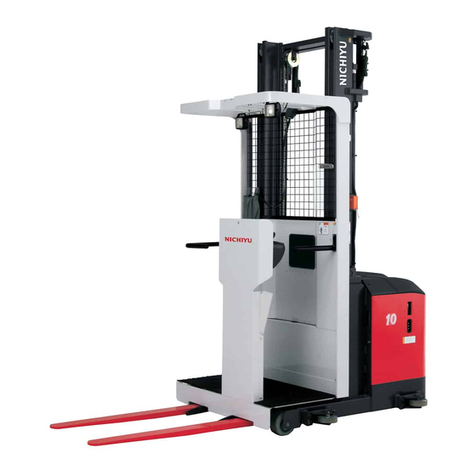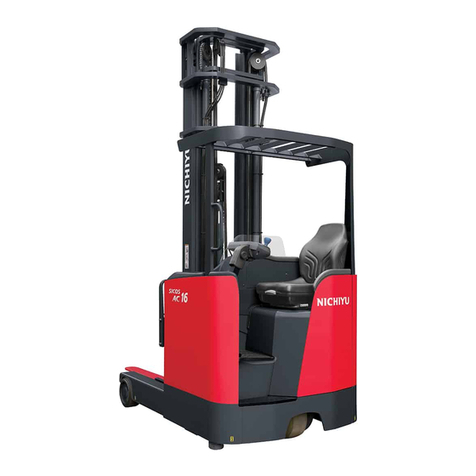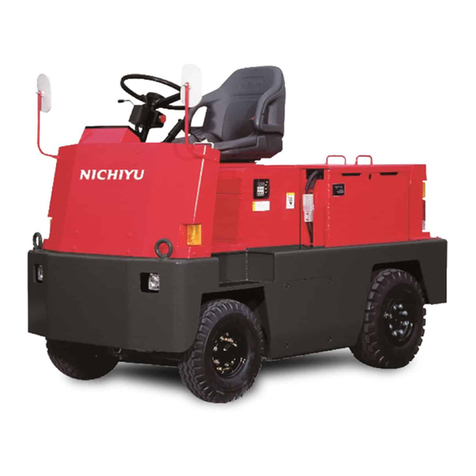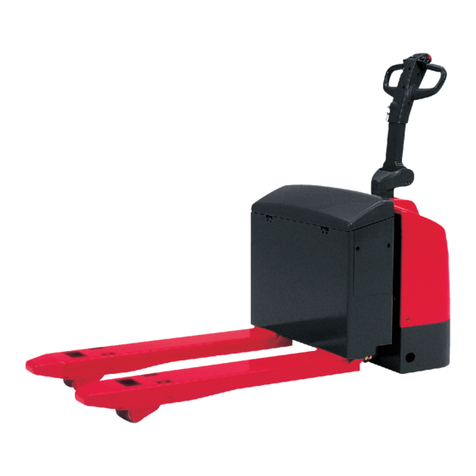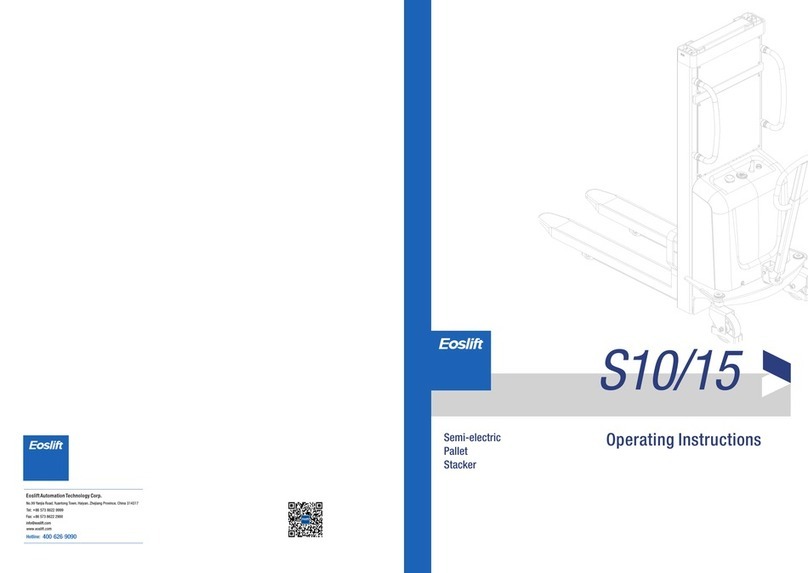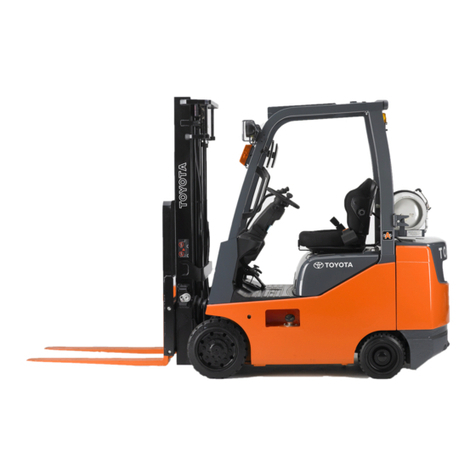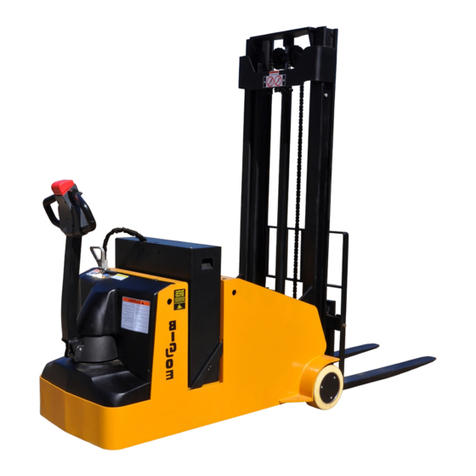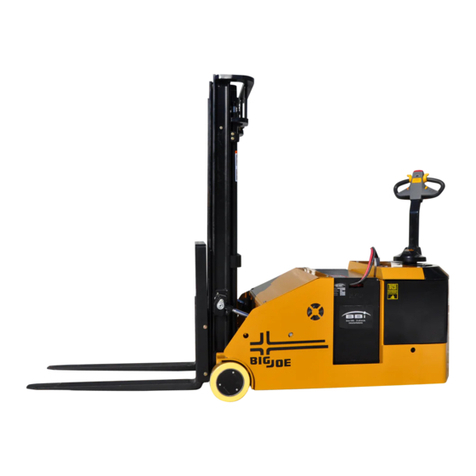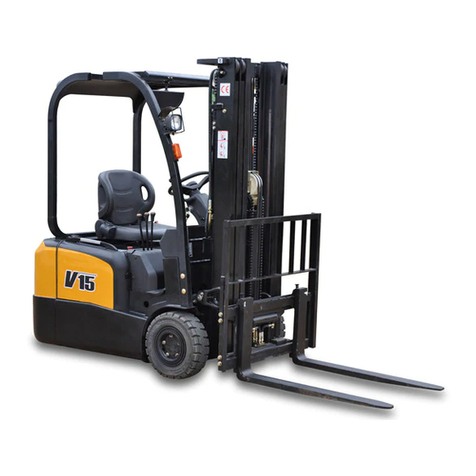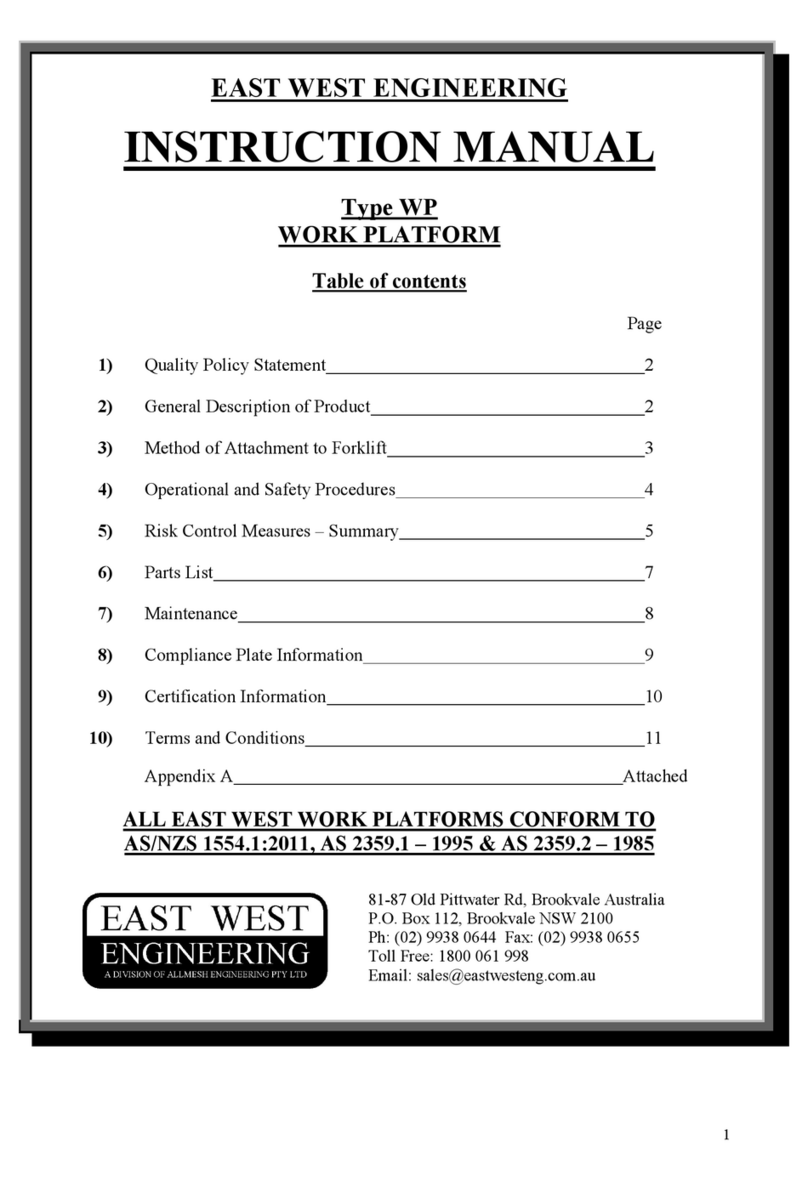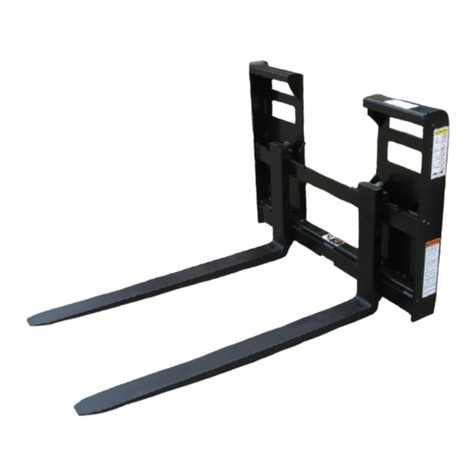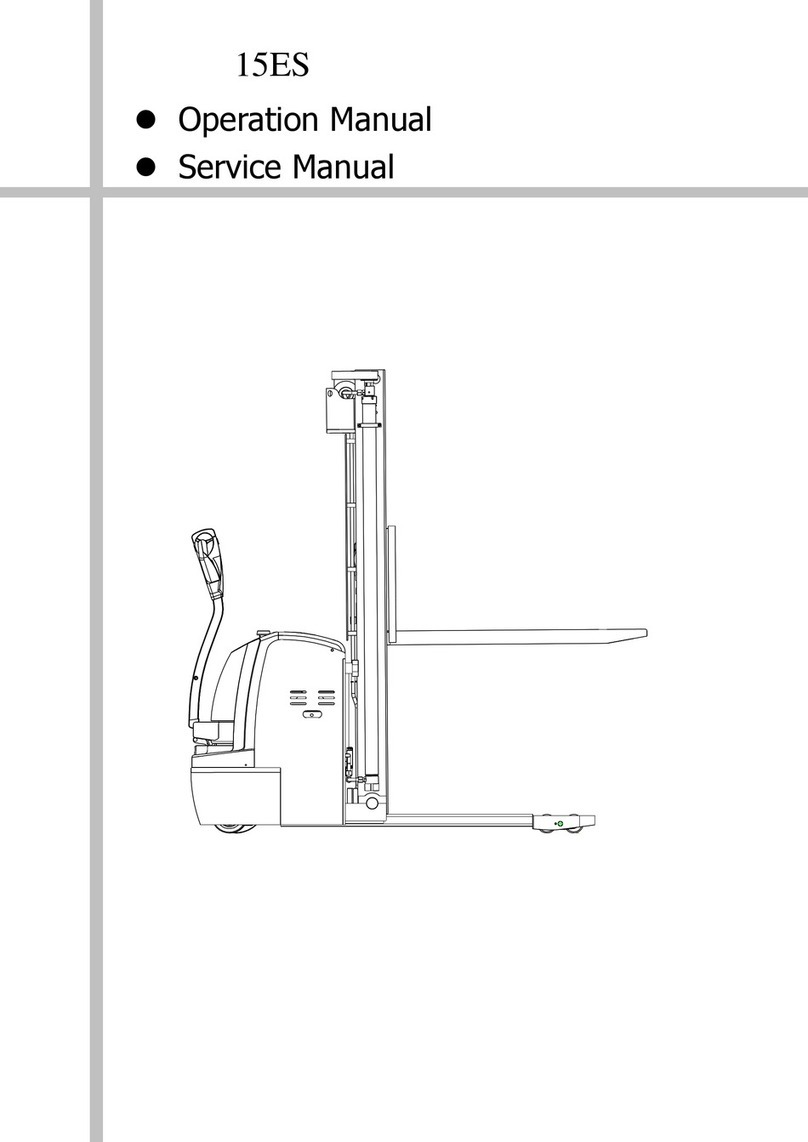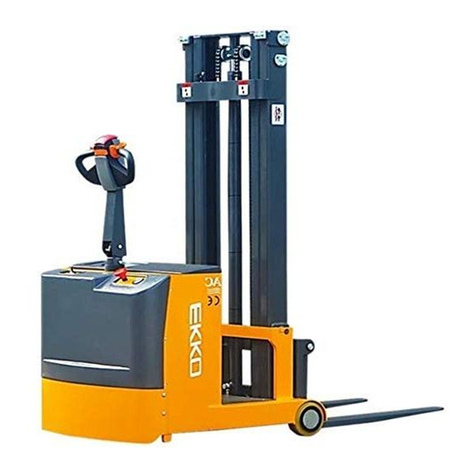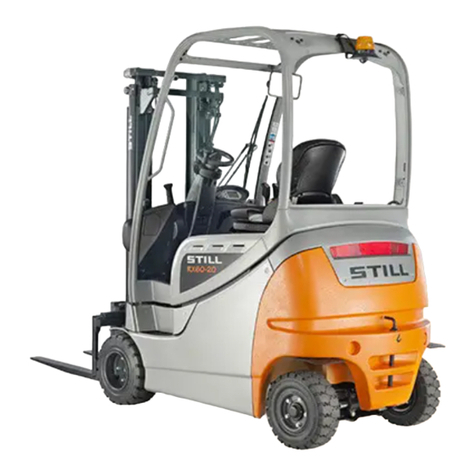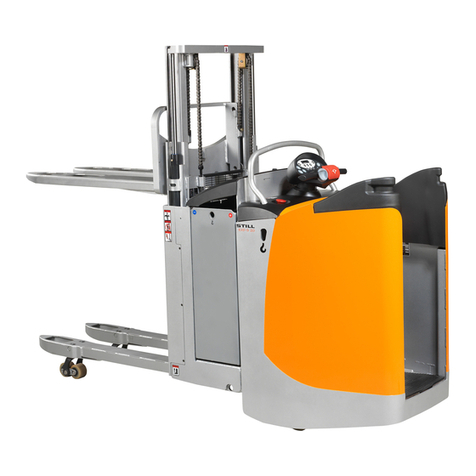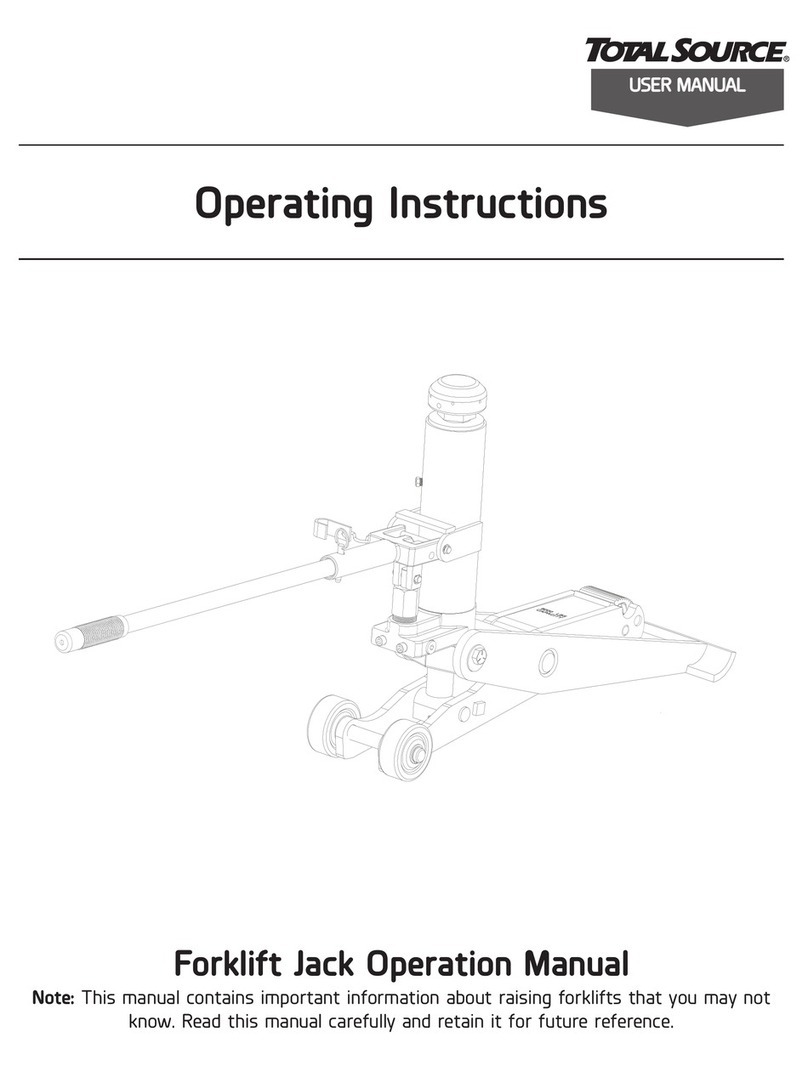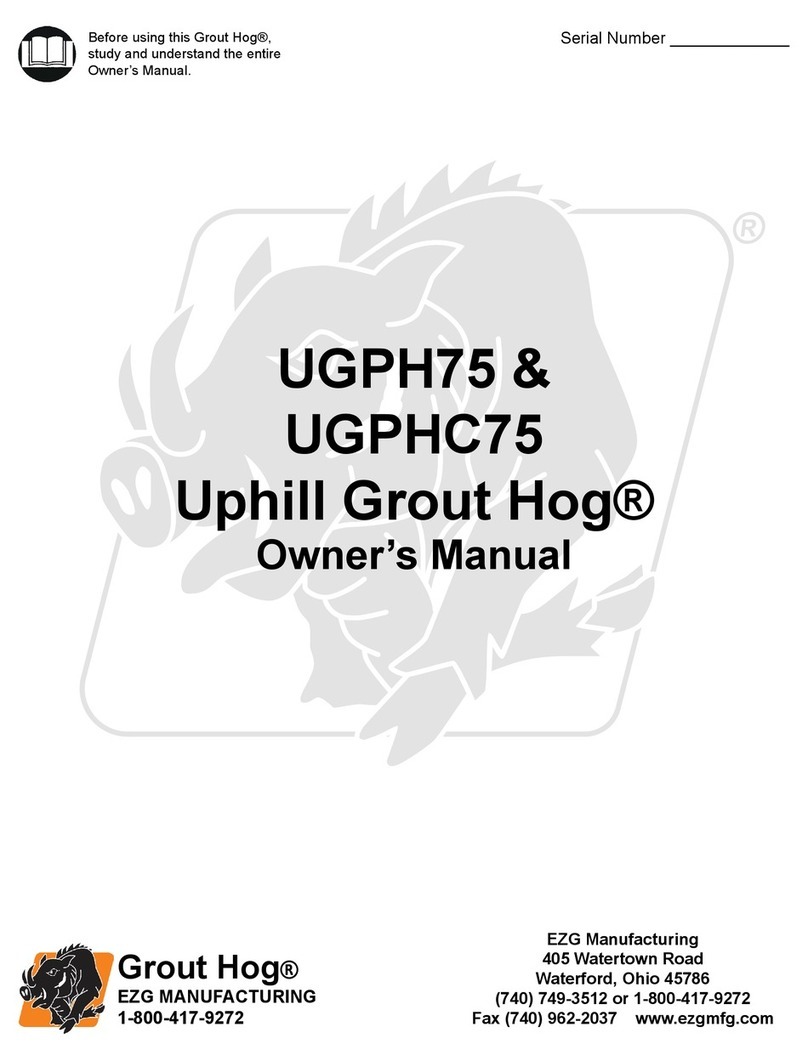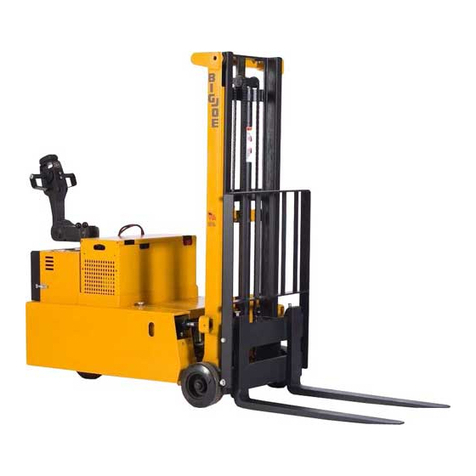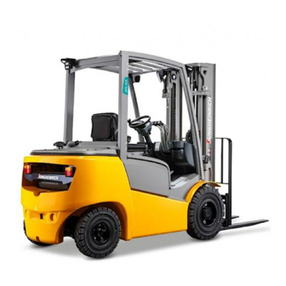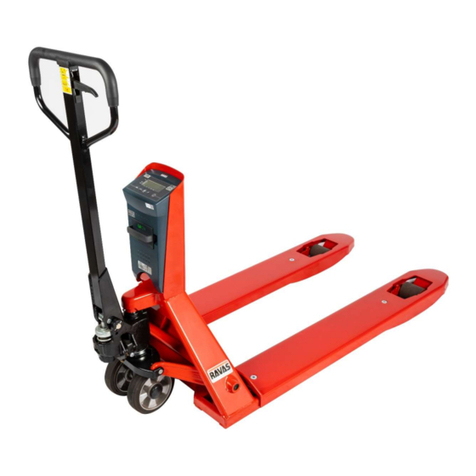NICHIYU 80 Series User manual

1-1, 2-Chome, Higashikotari, Nagaokakyo-shi, Kyoto 617-8585 JAPAN
Tel: +81-(0)75-956-8690 Fax: +81-(0)75-955-0584 URL: http://www.nichiyunet.co.jp/en
OPERATOR'S MANUAL
ELECTRIC LIFT TRUCK
FBT9P
FBT10P
FBT13P
FBT15P
FBT16P(B)
FBT18P(B)
FBT20P(B)N
80 SERIES
Unsafe use of this lift truck may cause serious injury or
death. Operators and maintenance personnel must read this
manual and be sure that they understand its contents before
operating, inspecting or carrying out maintenance on this lift
truck. This manual should be kept near the lift truck for
reference and periodically reviewed by all operators and
maintenance personnel who come in contact with it.
WARNING
Printed in Japan
Pub No. OP-12-001
200/1203
Copy rights
OPERATOR'S MANUAL FBT9P/10P/13P/15P/16P(B)/18P(B)/20P(B)N-80 Series
https://forklift-manuals.jimdofree.com

OPERATOR’S
MANUAL
ELECTRIC
LIFT TRUCKS
OPERATOR’S
MANUAL
https://forklift-manuals.jimdofree.com

https://forklift-manuals.jimdofree.com

• This operator's manual provides for the proper operation, easy maintenance and periodical
inspection.
• Prior to operation, read this manual carefully for safe and efficient operation.
• Specifications and equipment in this manual are subject to change without any notice by the
manufacturer for further improvement and modifications.
• Make sure these important instructions in this manual are available for the operator on each
delivery or transfer of the truck. Keep this manual after reading.
• If you have any questions, please feel free to contact your local NICHIYU dealer.
and are very important for you and others for safety. Follow these
instructions.
INTRODUCTION
The operator must read and understand the instruction of safe
operation contained in this manual.
DANGER Indicates an exteremely hazardous situation which, if not
avoided, will result in death or serious injury.
You must follow this instruction.
WARNING Indicates a potentially hazardous situation which, if not
avoided, could result in death or serious injury.
You must follow this instruction.
CAUTION Indicates a potentially hazardous situation which, if not
avoided, may result in minor or moderate injury.
You must follow this instruction.
NOTE Indicates suggestions, tips and hints related to the safety of
an operator and maintenance of a truck.
GENERAL
PROHIBITION If the prohibition is not kept, serious accidents can be
caused.
https://forklift-manuals.jimdofree.com

CONTENTS
1 . SAFE OPERATION 1
Safety decals and name plates .......................1
Information for safety operation.......................4
How to survive in a tip over .........................18
2.PART NAME AND FUNCTION 19
Name of part ....................................19
Driving equipment ................................19
Indicator panel...................................20
Indication of display...............................21
Function of display................................22
Various kinds of mode selection .....................28
Operating equipment..............................35
Laser pointer (Option) .............................41
3.DRIVING AND OPERATION 46
Preparation of start ...............................46
Traveling .......................................47
Stacking operation................................48
Picking operation.................................49
4.BATTERY AND CHARGER 51
Battery.........................................51
Precautions for charging the battery ..................54
Charger ........................................56
How to charge the battery (By stationary charger) .......58
How to charge the battery (By built-in charger)..........62
Exchanging battery ...............................74
Level of electrolyte and specific gravity................76
5.INSPECTION PRIOR TO OPERATION 78
Check point and contents ..........................78
Inspection procedure..............................79
6.INSPECTION AFTER OPERATION 83
Inspection after working............................83
7.PERIODIC SERVICING 84
Precautions of maintenance ........................84
Weekly (50-hour) servicing .........................87
Monthly (200-hour) servicing........................89
Lubrication points and recommended oil...............90
Every three-month (600-hour) servicing ...............91
Semiannually (1200-hour) servicing ..................91
Replacing parts and trouble shooting .................92
8.QUICK FAULT FINDING 93
9.PERIODICAL REPLACING PARTS 94
10.STABILITY OF FORKLIFT TRUCK 95
Load center and capacity...........................95
Stability of the forklift truck..........................96
11.SPECIFICATIONS 97
12.
COLD STORAGE TYPE FORKLIFT TRUCK (CS type)
99
Protection from rust and corrosion....................99
Protection from low temperature .....................99
13.SIDESHIFT ATTACHMENT 100
Sideshift attachment .............................100
Safe operation ..................................101
Part name and function ...........................102
Materials handling ...............................104
Periodical inspection and service ...................107
Periodical replacing parts .........................110
https://forklift-manuals.jimdofree.com

To know about safe operation
[1]SAFE OPERATION [P1]
[10]STABILITY OF FORKLIFT TRUCK [P95]
To know about specification of forklift
[11]SPECIFICATIONS [P97]
LASER POINTER [P41]
[12]
COLD STORAGE TYPE FORKLIFT TRUCK (CS type)
[P99]
[13]SIDE SHIFTATTACHMENT [P100]
OPTIONS
To know about procedure of operation
[2]PART NAME AND FUNCTION [P19]
[3]DRIVINGAND OPERATION [P46]
To know about battery and charger
[4]BATTERYAND CHARGER [P51]
To know about periodical inspection and maintenance
[7]PERIODIC SERVICING [P84]
[5]INSPECTION PRIOR TO OPERATION [P78]
[6]INSPECTIONAFTER OPERATION [P83]
[9]PERIODICAL REPLACING PARTS [P94]
To know about procedure of
countermeasure for break down
[8]QUICK FAULT FINDING [P93]
1
2
3
4
5
6
7
8
9
10
11
12
13
https://forklift-manuals.jimdofree.com

https://forklift-manuals.jimdofree.com

1SAFE OPERATION
1
1
Safety decals and name plates
Safety decals and name plates are installed on
the forklift truck to give information about pos-
sible hazards.
If you find that the decals and name plates are
removed and/or unreadable, contact your local
NICHIYU dealer for replacement.
▌Indication of direction (Right side / Left side)
The following illustration shows the direction of this forklift truck
from the operator's compartment.
A : Front
B : Rear
C : Left
D : Right
▌Decals and Name Plates
12
2
4
13
14
2
5
7
(for built-in charger)
3
8
3
(for stationary charger)
12
11
9
10
6
A B
C
D
https://forklift-manuals.jimdofree.com

2
1. SAFE OPERATION
1 3
2
4
5
警告
WARNING
警告
WARNING
1. Charge the battery only in approved and well ventilated area
without smpking, flames and / or sparks.
(Flammable gas will be generated by the battery while charging.)
2. Open the battery cover fully when charging the battery.
3. Inspect any damages on the charger cable before charging
the battery.
4. Do not use the cable if any damages or transformation are found.
5. Grab the plug itself when connecting or disconnecting the cable.
Do not pull the cable when disconnecting to avoid damages.
6. Insert the plug completely to the end of the receptacle.
Improper connection may cause overheating or burning
while charging the battery.
7.
Do not disconnect the plug while charging. it may create sparks.
8.
Push the "STOP" button when interrupting to charge before.
9.
If any abnormalities are found on the cable or plug such as
abnormal heating, electric shocks, loosing connection, any
transformations disconnecting the plug. or damage of parts,
stop charging immediately and repair them.
SAFETY PRECAUTIONS FOR CHARGING BATTERY
50008-34910-0
CAUTION
6
WARNING
Fasten
Seatbelt
Do Not Jump ! Lean Forward
Hold
On
Tight
Brace
Feet
IN CASE OF TIPOVER
Lean
Away
From
Impact
Truck can
TIP OVER !
Risk of serious
INJURY
or DEATH
1.
2.
3.
Lateral tipover can occur when unloaded if the combination of speed and
sharpness of turn produces an overturning moment which exceeds the
stability of the truck.
Lateral tipover can occur if overloaded or loaded within capacity and the
load is elevated and if turning and/or braking when traveling rearward or
if turning and/or accelerating when traveling forward produces an overturning
moment which exceeds the stability of the truck.
Rearward tilt and/or off-center positioning of the load and/or uneven
ground conditions will further aggravate the above conditions.
Longitudinal tipover can occur if overloaded or when loaded within
capacity and the load is elevated if forward tilt. braking in forward travel.
or commencing rearward travel produces an overturning moment which
exceeds the stability of the truck.
Serious injury or death can occur to the operator if he/she is trapped
between the truck and the ground.
4.
The operator should stay with the truck if lateral or longitudinal tipover
occurs. The operator should hold on firmiy and lean away from the point
of impact.
The operator should stay with the truck if it falles off a loading dock or
ramp. There are other situations where the environment of the landing
area presents a severe hazard. In those incidents. it may be prudent for
the operator to leave the truck.
1.
2.
FOR SAFETY NOTICE FOLLOWING WARNINGS
IN CASE OF TIPOVER
24700-04830
7
8
Lock release method of gas spring
9
This is to certify that this is a new fork lift truck
which has been manufactured for exportation by
as stated in the certificate issued by them.
10
Apply parking brake before
leaving truck. Make adjust
to provide adequate braking.
https://forklift-manuals.jimdofree.com

3
1. SAFE OPERATION
12
11
PRECAUTIONS FOR SAFETY OPERATION
1
Do not overload. observe allowable load (blue zone).
2 Prior to operation, check performance of brake
or turn quickly.
3 Do not make a sudden start and brake or turn
quickly.
4 Do not make a sudden valve lever operation at a
high lift.
5 Do not run sideways or handle on an incline.
6 When the red lamp of battery capacity indicator
turns on, charge battery.
7
Check electrolyte every week and replenish water.
8 Be sure to use the prescribed fuses.
14
13
(with japanese battery only)
• GASES produced by this battery can be explosive.
Cigarettes, flames, or sparks could cause battery to explode.
Make sure batteries are stored and charged in a well–ventilated area.
• Batteries contain SULFURIC ACID can cause severe burns.
Avoid contact with skin, eyes or clothing.
• In event of accident flush with water and call a physician immediately.
• Wear rubber gloves to prevent ELECTRIC SHOCK during
checking and maintaining.
• Keep out of reach of children.
IMPORTANT POINT FOR MAINTENANCE
1. Maintain the proper electrolyte level.
(When electrolyte is low fill with purified water to the white
portion of the float, as shown in the figure.)
2. Always keep the batteries fully charged,
do not overdischarge them.
3. Keep the battery surface clean.
WHITE
FLOAT
AB
MAST 500 CAPACITY SPECIFIED FOR THE TRUCK REQUIRES TIRES
AUTHORIZED BY MANUFACTURER.
IMPROPER OPERATION OR MAINTENANCE
COULD RESULT IN INJURY OR DEATH.
VERTICAL
50008-77841(英)
SERIALNO.
FRONTTIRE
SIZE
REAR TIRE
SIZE PRESSURE
FR/RE
TIRE
MAX REARWARD
MASTTILT
LOAD TIRE
TREAD WIDTH
BATTERY
WEIGHT
SERVICE WEIGHT
W/O BATTERY
MODEL
ACTUAL
CAPACITY/LC
SERVICE WEIGHT
NIPPON YUSOKI CO.,LTD. KYOTO JAPAN
VOLTAGE
MFG YEAR
mm
kg /
kg /
Akg
mm
V
kg
kPa
Fr Re
MIN. MAX.
Bmm
mm
FORK ONLY ATTACHMENT
LOAD CENTER
MAXIMUM
LIFT HEIGHT
Fr kPa Re kPa
kg
kg
kgkg
mm
deg.
ACTUAL
CAPACITY ACTUAL
CAPACITY
LUBRICATION 1200 HOURS
600 HOURS
200 HOURS
リフトバー
ドライブアクスル
ブレーキマスターシリンダー
ステアリングシャフト
ステアリングチェン
ステアリングギヤボックス
STEERING CHAIN
STEERING SHAFT
BRAKE MASTER CYLINDER
DRIVE AXLE
LIFT BAR
ティルトシリンダロッドエンド
TILT CYLINDER ROD END
MAST SUPPORT
LIFT CHAIN
HYDRAULIC OIL TANK
PIVOT HOUSING
WHEEL SHAFT
STEERING GEAR BOX
マストサポート
リフトチェン
オイルタンク
ピボットハウジング
ホイールシャフト
TO
B0
RG
G
GO
B0
G G
G
G
G
G
HO HO
: LUBRICATION
給油
: REPLACE
交換
: CHECK AND ADJUSTMENT
点検調整
50008-764900-0(英・和)
: BRAKE OIL
ブレーキオイル
: RUBBER GREASE
ラバーグリース
: TRANSFER OIL
トランスファオイル
G
GO
HO
: CHASSIS GREASE
シャーシグリース
: GEAR OIL
ギヤーオイル
: HYDRAULIC OIL
作動油
BO
RG
TO
https://forklift-manuals.jimdofree.com

4
1. SAFE OPERATION
Information for safety operation
Do not operate forklift truck while taking
drugs and/or alcohol; otherwise, an acci-
dent may occur which can cause serious
injury or death.
Only a trained and authorized operator shall
operate the forklift truck.
The operator is recommended to wear a helmet,
safety shoes and working clothes.
Do not use a forklift truck in the following cir-
cumstances.
Where the explosive gas (thinner, gasoline
etc.) may exist.
When using a forklift truck in the following area,
consult your local NICHIYU dealer before opera-
tion.
1. Where the explosive materials such as gun-
powder are exist.
2. The dusty place.
Keep the operator's compartment clean at all
times.
Do not operate the forklift truck with greasy or
wet hands.
● These designed features are incorporated to protect
the operator from falling loads.
● Make sure they are in place and in good condition.
● Precautions still should be exercised by the operator
for possible falling objects or impacts.
NICHIYU forklift trucks are equipped with an
overhead guard and load backrest extension.
● Modifications and additions shall not be performed
without the written approval of NICHIYU. Contact
your local NICHIYU dealer for details.
● Do not install any parts blocking visibility from oper-
ating position.
Do not modify the forklift truck.
https://forklift-manuals.jimdofree.com

5
1. SAFE OPERATION
Carry out the daily inspection before operation.
● Stop operation and report immediately for any
damage or faults on the forklift truck.
● Do not operate the forklift truck until it is
repaired completely.
Do not overload. Failure to observe the
rated capacity can cause the forklift truck
to tip over.
● Refer to the load chart and make sure that the
weight and the load center are within the capacity of
your forklift truck before handling. If the attachment
is installed on the forklift truck, the maximum capac-
ity should be reduced. Read the instruction manual
of the attachment before operation.
Use proper size pallet with enough strength for
the load.
https://forklift-manuals.jimdofree.com

6
1. SAFE OPERATION
Make sure that the load is palletized securely in
a proper shape. If a load is unstable, it can eas-
ily shift and fall on someone.
● Make sure no person is around the forklift truck
before starting.
Look all around the forklift truck before moving.
Travel in backward if forward visibility is
blocked.
● If the load blocks your view, or when you travel down
a grade with a load, drive backward. Always look
in the direction of travel. A look-out helper may be
required if your visibility is obstructed.
Make sure no person is around the forklift
truck when traveling in backward. Look around
behind the forklift truck and sound the horn
before moving.
● If you cannot see where you are going, don't move!
Travel slowly around corners.
● Sound the horn at cross aisles and other areas
where you cannot see clearly or where visibility is
restricted.
Stop at blind corner and/or intersection.
https://forklift-manuals.jimdofree.com

7
1. SAFE OPERATION
● Always be aware of people near your forklift truck.
Do not proceed near them until they are aware of
you.
Always look in the direction of travel!
● Always make sure that the tail swing area is clear
before turning.
● When turning in aisles, especially narrow aisles,
keep as far away as possible from stock and racks.
Be extra cautious near people.
● Failure to observe the tail swing area when making a
turn can injure or kill someone.
Be aware of tail swing.
● A sudden start or braking can cause the load to fall.
● A sharp turn while traveling can cause the forklift
truck to tip over.
Do not make a sudden start, stop or turn.
https://forklift-manuals.jimdofree.com

8
1. SAFE OPERATION
● Avoid bumps, holes, spill spots and loose materials
that may cause the forklift truck to swerve or tip. If
unavoidable, slow down, and proceed with caution.
Do not go over obstacles, curbs, ditches, ridges
and railroad trucks.
Always check road surface, and stay away from
soft or uneven ground to avoid a tip over.
● Water, sand, gravel, ice or mud can cause a tipover.
If unavoidable, slow down.
● Do not go into a flooded or water covered area.
Avoid slippery surface.
● Serious accidents can be caused by hitting pipes
and beams near the ceiling with mast or overhead
guard. Make sure there is enough clearance for ceil-
ing and height limit of the entrance.
Keep enough clearance.
● A forklift truck is very heavy. Check the condition of
the driving surface. Make sure the floor, bridge and/
or elevator will support the weight of the forklift truck
and the load.
Do not exceed the limitation of the floor
strength.
https://forklift-manuals.jimdofree.com

9
1. SAFE OPERATION
● Traveling while lifting the forks can cause the unsta-
ble condition to tip the forklift truck over.
● The fork height should be about 200mm from the
ground and the mast (fork) should be tilted back
while traveling.
Do not travel while the forks are in the raised
position.
● Do not lift the load by the tip of the forks.
● Misuse can damage the loads as well as the forklift
truck.
Do not push or drag the load.
Do not drag any loads with rope by the lift car-
riage or load backrest.
https://forklift-manuals.jimdofree.com

10
1. SAFE OPERATION
Never allow anyone to walk or stand
under raised forks.
● Never allow anyone to ride on forklift
truck other than operator.
● At no time shall anyone be allowed to
ride on forks of forklift truck.
Keep enough distance from the edge of docks,
ramps and platforms.
https://forklift-manuals.jimdofree.com

11
1. SAFE OPERATION
● When traveling up or down the grades, keep the load
upside to maintain control.
● Travel down with foot or plugging brake if necessary.
Travel carefully on grades when loading.
● Failure to observe this rule can cause the forklift
truck to tip over.
Do not turn on, or angle across an incline.
● If the weight of the load is not centered between the
forks, the load can fall from the forks when you turn
a corner or hit a bump.
● An off centered load will increase the possibility of
the forklift truck tipping over to the side.
Do not handle an off-center load.
Never put any parts of your body into
mast structure or between mast and fork-
lift truck.
Do not climb on the mast or overhead
guard.
Operate all levers and switches from the driv-
er’s compartment.
https://forklift-manuals.jimdofree.com

12
1. SAFE OPERATION
Do not put any part of your body outside
operator's compartment of forklift truck.
● Keep hands and feet inside the operator's compart-
ment.
Operate hydraulic control levers slowly when
loading or unloading.
● Failure to observe this instruction, can cause the
forklift truck to tip over.
Do not lower and stop the load suddenly.
● Tilt the mast (fork) up enough to stabilize the load.
Do not lift-up, down and travel on tilting the
mast (fork) down when loading.
Pay attention to keep enough clearance for the
mast and overhead guard when going into the
container.
● Make sure the trailer brakes are set and the wheels
are blocked while loading or unloading.
Drive into a trailer carefully.
https://forklift-manuals.jimdofree.com

13
1. SAFE OPERATION
● Do not grasp the steering wheel or hydraulic levers
to ride forklift truck.
Do not jump on or off the forklift truck.
● When handling double stack loads, fasten together
with a band to prevent the load from falling.
Do not pick the loads up beyond the backrest
extension height.
● It is dangerous to have chains and hoses that are
loose. It can cause the load to catch, racking by the
forks or falling loads.
Do not pull the forks out from a pallet if chains
and hoses are loosen.
When chains and hoses are loosen :
● Lift the forks a little until correcting chains and hoses.
● After correcting chains and hoses, pull the forks out
from a pallet.
● Misuse can cause an accident as well as property
damage.
Do not abuse forks.
https://forklift-manuals.jimdofree.com
This manual suits for next models
10
Table of contents
Other NICHIYU Forklift manuals
